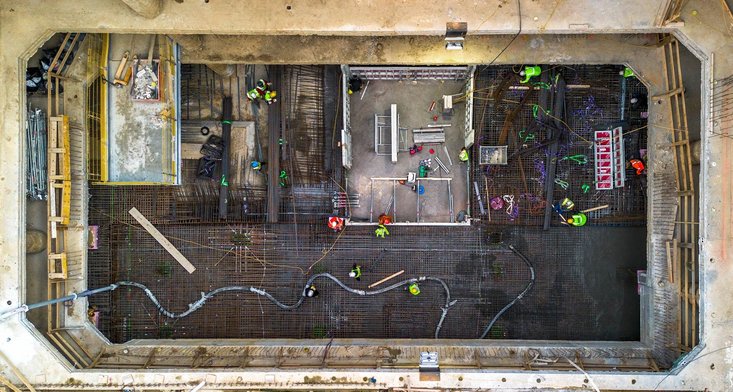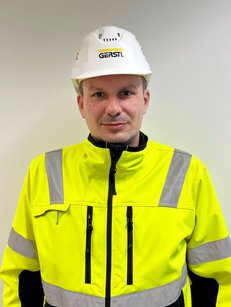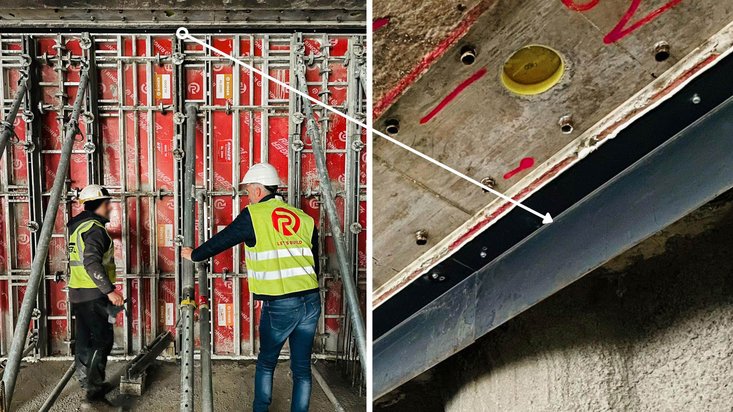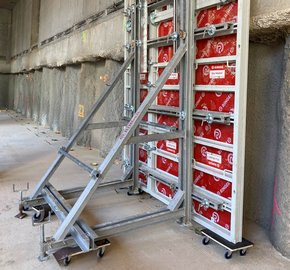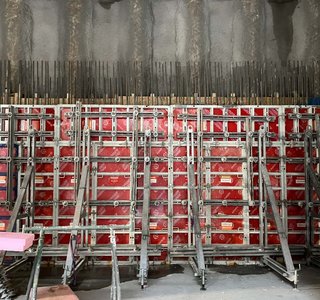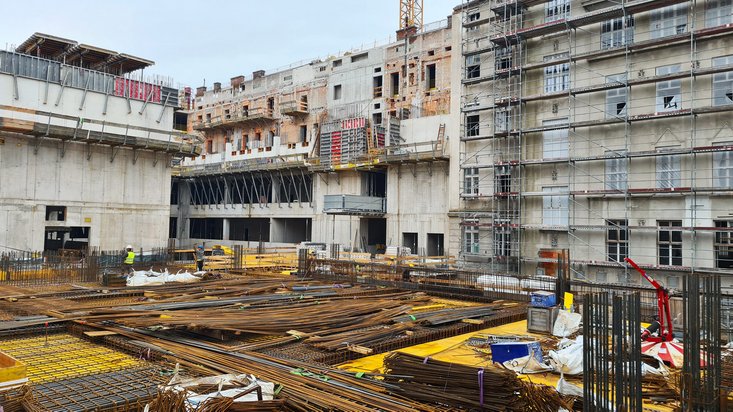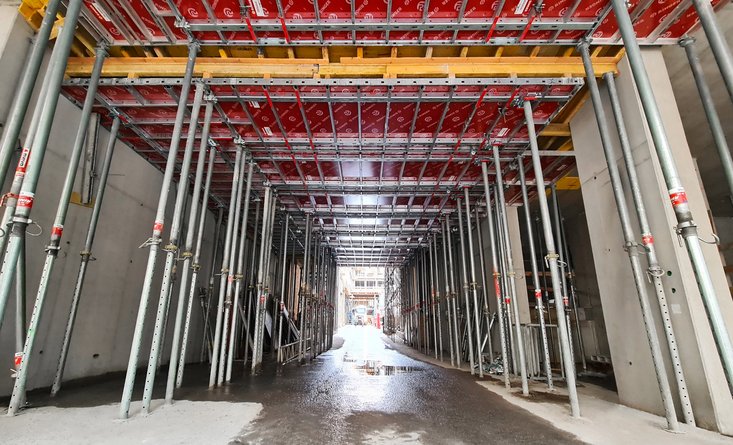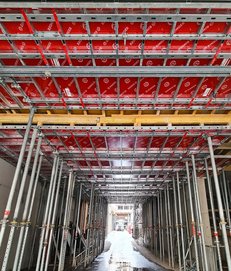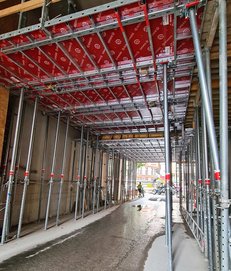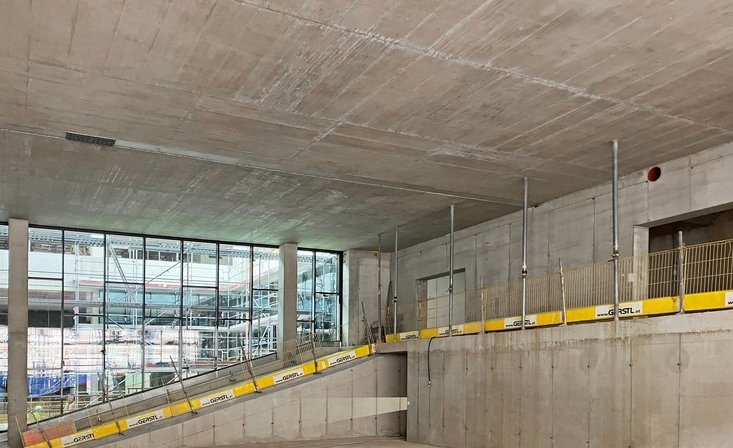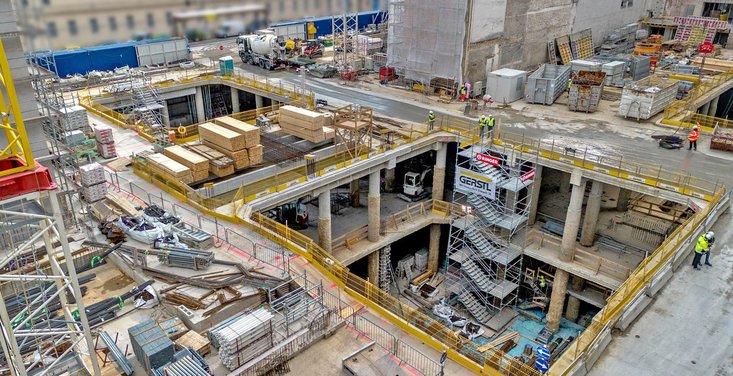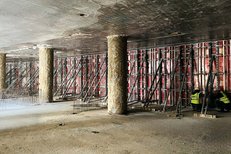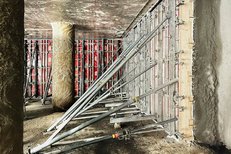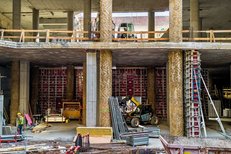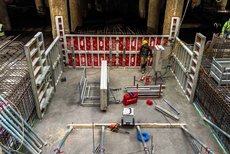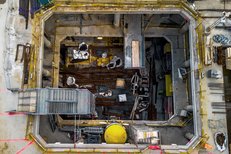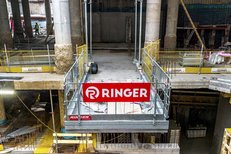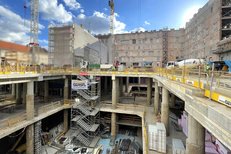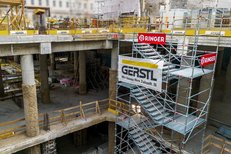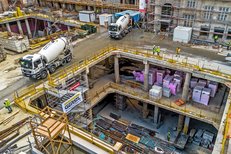
Project data
Country: Austria
Application: Wall
Building owner: Bundesimmobiliengesellschaft
Construction company: GERSTL BAU GMBH & CO KG
Products in use
AL2000Alu MasterDouble Railing Scaffolding Modular Stairs Brace Frame M Floor Props
In the heart of Vienna, at the junction of Mariannengasse and Spitalgasse, a monumental center for research and teaching is being built on behalf of the Bundesimmobiliengesellschaft (BIG): the MedUni Campus. This ambitious construction project, which has an investment volume of EUR 395 million including state-of-the-art facilities and initial equipment, will provide a new home for up to 2,000 students and 750 researchers on 35,000 m².
The entire project area is divided into six components. The campus is divided into general areas, teaching areas and research areas. Lecture halls and seminar rooms for students are located on the lower floors, with three large lecture halls on the first floor of the main building directly adjoining inner courtyards and thus receiving natural daylight. Seminar and practice rooms are located on the first and second floors, both in the old and new buildings. There are also learning zones and informal areas for students. Research areas are located from the second to the seventh floor. The centrally located canteen is on the first floor.
Cover construction with gigantic dimensions
The imposing building complex, which is being erected over several construction phases and will ultimately have a net floor area of 56,300m², is being built using the so-called cover construction method. Starting from the edge of the terrain, bored pile walls and additional temporary auxiliary bored piles were constructed to transfer the load.
A continuous cover, which forms the first floor and has various logistics openings, was then concreted over the walls and columns prepared in this way. This was followed by the excavation of the earth in several sections and the construction of the intermediate ceilings down to the foundation depth of 17m below ground. Once the basement floors had been completed, the temporary auxiliary bored piles of the cover structure could be replaced by the final load-bearing walls and columns for the necessary load transfer.
Formwork and scaffolding systems from the RINGER rental service were used in the realization of this complex construction project. In view of the challenges involved in maneuvering the formwork in the cover construction method, the load-bearing capacity and low weight of the RINGER formwork proved to be particularly advantageous. RINGER also supported GERSTL BAU GMBH & CO KG, the company responsible for the main construction site, with valuable technical expertise, innovative solutions and high-quality materials to ensure efficient construction progress.
Construction of the load-bearing walls with AL2000 and Alu Master
GERSTL BAU chose the lightweight AL2000 aluminum formwork from RINGER to create a flat surface along the bored pile walls. In contrast to the cover construction method, where construction is initially carried out from top to bottom, the walls were constructed in reverse from bottom to top. For this reason, most of the material handling had to be carried out without a crane. The first step was to assemble the formwork and secure it with Push-Pull Props. Instead of upper formwork, sheet steel angles were attached to the ceiling beforehand, which are flush and tight with the formwork at a height of 12.5 cm and slightly inclined to the formwork. The foam concrete with a density of 300 kg/m³ required for the leveling was then introduced from above the ceiling through pipes that had already been set in concrete in advance. For the thermal insulation of the heated basement areas, 12 cm thick XPS boards were then laid on the leveled foam concrete surface.
Based on the white tank, the actual reinforced concrete wall could then be erected. In view of the limited space available on the individual storeys and the fact that it was not possible to manipulate formwork elements by crane using the cover construction method, GERSTL BAU relied on mobile support frames, among other things, for the load-bearing walls. This is a special solution that was developed specifically for this project. For this purpose, Alu Master formwork elements were pre-assembled into formwork units, equipped with the RINGER Brace Frame M and placed on wheels. This approach allowed GERSTL BAU to move the Brace Frames efficiently, even in confined spaces, which resulted in significant time savings.
Once the reinforcement work was complete, the Alu Master formwork units were conveniently positioned using rollers and fixed in place professionally. Wherever space allowed, the formwork assemblies were lifted into place using adapted cranes or excavators. The concrete could then be poured from the upper levels through larger prefabricated holes.
A crane-free solution was also required for the formwork of the numerous columns in the building. The Alu Master wall formwork proved to be ideal here, as it is easy to handle and enables both fast and safe working.
Combined formwork technology with special solution
For all those walls with a concreting height of 6 meters, a combined formwork technique with Alu Master was used. First, the formwork elements were secured in the lower wall area using Brace Frame M and concreted up to a height of 3.5 meters. To ensure anchor stability when concreting the formwork level above, a connection was also concreted into the upper area of the first formwork level using plate anchors (8mm flat bar, 10x12cm, DW 15 tie rod welded in the middle). Subsequently, three 270x90cm Alu Master panels were mounted transversely on climbing platform adapters. The formwork was secured to the panel anchor with vertically attached tie bolts at 3m in the lower area and additionally fixed with alignment rails 150 using anchor sleeves. In the upper area, sheet steel angles were mounted on the ceiling soffit to absorb the horizontal forces.
Impressive construction facts
> Various sections of this extensive project are characterized by their impressive dimensions. One bracing wall in particular, required to support a very large load in this area, reached impressive dimensions of 12m long, 6m high and 85cm thick. The RINGER double railing scaffolding served both as reinforcement scaffolding and as working scaffolding for the concreting work.
> During the peak phases of the project, there was a high demand for formwork materials. For example, the shell construction required up to 400 units of Alu Master wall formwork elements measuring 270 x 90 cm in certain sections.
> An impressive 120m³ of concrete was processed per day for the walls alone. In order to be able to handle these considerable quantities efficiently, a stationary concrete pump was used for the concreting work, which was filled by mixer trucks. The concrete was distributed across the huge area using a specially designed pipeline system.
> During the most intensive construction phases, around 45 tons of construction steel were processed per day . This corresponds to a daily load weight of two articulated trucks.
RINGER loading platform for efficient material handling in the basement
In contrast to the usual application in building construction, the unloading platform also offers considerable advantages in basement levels for top-down construction, as the handling of materials with the crane is only possible to a very limited extent here. With a total length of 8.50 m and a usable area of 5 x 2.6 m, it creates extensive space for transporting building materials, equipment and devices by crane between the various floors and also serves as a temporary storage location.
This solution thus maximizes the available space on the construction site and also considerably increases the efficiency of the logistics processes. Equipped with a maximum load capacity of 5 tons, the RINGER loading platform was fixed between the storeys using floor props, which guaranteed GERSTL BAU a smooth and safe transfer of materials.
Floor connection with modular stairs and scaffolding stair tower
Two modular stairs were used on this construction site to facilitate access to the lower floors as part of the cover construction method. They were also used to ensure effective evacuation in an emergency. With a width of 1.25 m, the stairs offer optimum conditions for carrying people safely in an emergency.
On a total of nine scaffolding levels (each 1.5 m high), the wide steps also ensured comfortable access and egress during daily site operations. The easy handling of the modular stairs enabled them to be erected quickly, cost-effectively and flexibly, making them an indispensable component for logistics and safety on the construction site.
A RINGER double railing scaffolding stair tower was used to make the existing buildings accessible outside the cover construction. This construction, which extended over 12 storeys and a height of 24 meters, optimized access to the various levels.
For efficient access to different areas of the construction site with just one scaffolding stair tower, it was lifted several times by crane to the desired position.
The MedUni Campus Vienna , an ambitious construction project that will offer state-of-the-art research and teaching infrastructure, is aiming for construction completion by the end of 2026. In order to keep to the schedule, work will be carried out in shifts over a 6-day week.
The realization of such a challenging project can only be guaranteed by a top construction site team. Special mention should be made of DI Klemens Egger-Peitler (construction management) and Mr. Stadler Martin (foreman). We would like to thank everyone involved for their excellent cooperation and look forward to continuing this successful partnership in future projects.
In April, we reported on the ambitious construction project for the MedUni Vienna campus. Since then, construction has progressed rapidly and is now in its final phase. Work is being carried out at full speed in every nook and cranny to complete the shell of the building. Where our ceiling and wall formwork was previously used for concreting, all the installations are currently being installed and the impressive building complex is taking shape.
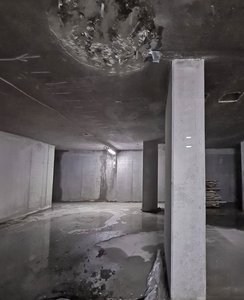
Temporary auxiliary columns were erected for the cover construction method used for the 4 basement floors as part of the project. With the completion of the ceilings and the erection of the final columns, these temporary elements can now be gradually removed.
This process required precise planning and execution to ensure the stability of the construction at every stage. The removal of the temporary columns now makes the progress clearly visible and the final load-bearing elements take over their function.
Efficient logistics thanks to flexible formwork technology
Special measures were implemented to optimise site operations and facilitate material transport. In areas that had not yet been concreted and were shuttered with DEKplus slab tables, the floor props were placed at a greater distance from each other. The flexible swivelling head of the slab tables also made it possible to temporarily incline the innermost row of floor props. These adjustments ensure the required passage width for lorries without compromising the stability of the formwork. This means that the lorries can still access the interior of the building shell through passages, which makes the logistics processes considerably easier.
The main advantage of the double-sided swivelling prop head from RINGER compared to other systems is the significantly lower weight and greater stability of the table. The prop head can be mounted at any position, can be swivelled in both directions, can be operated from the ground and locks automatically and securely when swivelled back.
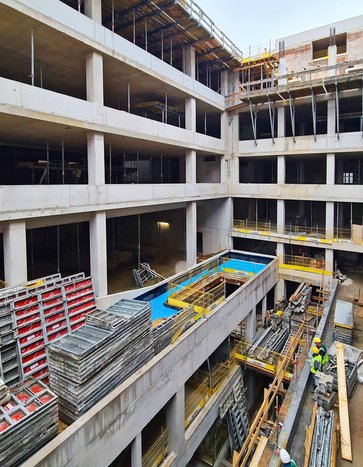
Parallel to the dismantling of the temporary auxiliary columns, work has begun on the interior fit-out. Installations for electrics, plumbing, heating and cooling are being installed to create the building's functional infrastructure.
The rooms previously constructed with RINGER formwork solutions are now being filled with life and prepared for their future use.
In addition, the mullion and transom façade is being constructed, making the characteristic appearance of the building increasingly visible.

